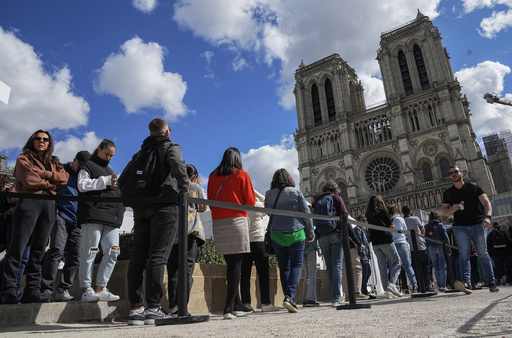PARIS — As Notre Dame prepares to welcome visitors again in December, the city of Paris is heading towards a significant eco-friendly transformation, emphasizing a return to nature in the City of Light.
In addition to restoring the cathedral’s renowned spire and medieval aesthetics, the city unveiled plans worth 50 million euros (approximately $55 million) to enhance the surroundings of Notre Dame, aiming to create a peaceful and green environment.
This initiative is part of a larger post-Olympics renovation effort that aims to reconfigure the entire city, extending from its historic landmarks to busy streets and avenues. Key aspects of this overarching transformation include rejuvenating significant areas, such as the Champs-Elysees and Place de la Concorde, redesigning traffic patterns near the Arc de Triomphe, and establishing green walkways linking various attractions throughout the French capital.
In terms of specific projects, the upcoming reopening of Notre Dame Cathedral on December 8 is set to be a pivotal moment for Paris. This reopening fulfills President Emmanuel Macron’s commitment made in response to the catastrophic fire in 2019, which had a recovery timeline of five years. With the restoration of the spire and oak-raftered roof nearing completion, the city government plans to reimagine the area surrounding Notre Dame.
The forward-thinking concept envisions the creation of 1,800 square meters (about 20,000 square feet) of green space and involves the planting of 160 trees, as detailed in a recent press conference by Paris officials, including Mayor Anne Hidalgo. She highlighted that the redesign will merge more of nature with the Seine, aiming “to better highlight our beautiful cathedral and do it justice, while respecting its history.” The strategy involves converting the underground parking area into a visitor-friendly space complete with necessary services.
Moreover, the quays adjacent to the Seine will see revitalization efforts, creating a new promenade that enhances the riverfront experience. A viewing area will be established to offer sweeping vistas of the Ile Saint-Louis and the Seine, enriching the experience for visitors even further.
This project will unfold in two phases, with the initial phase centered on the plaza and nearby streets expected to be finished by late 2027. The second phase will include the redone Square Jean-XXIII and surrounding locales, aiming for completion by 2030.
In the heart of the city, the Place de la Concorde, home to the ancient Luxor Obelisk, is poised for a major transformation slated for completion between 2026 and 2027. City officials have sought advice from various architectural experts to ensure the plaza retains its historical integrity while aligning with modern eco-conscious objectives. The renovation promises to bring in more greenery and manage traffic flow better while embracing a fresh design approach.
However, not all aspects of Paris’s post-Olympics plans have gone smoothly. A notable dispute has arisen between two prominent female politicians: Hidalgo and Culture Minister Rachida Dati. The contention revolves around the future of the iconic Eiffel Tower and whether to keep the Olympic rings displayed beyond the end of the Games in August. Hidalgo argues the rings represent the “festive spirit” of the successful Paris Olympics and should stay until the next Summer Games in Los Angeles in 2028.
Critics claim that Hidalgo is leveraging the Eiffel Tower for personal gain in light of the upcoming 2026 mayoral election. Dati has opposed Hidalgo’s proposal on the grounds that the Eiffel Tower is a protected heritage site and cannot be altered without due consultation. She has accused Hidalgo of using the landmark as a “personal campaign poster,” while Hidalgo maintains that the rings simply celebrate Paris’ Olympic achievements.
Furthermore, Dati has put forth an ultimatum to designate the Eiffel Tower as a full historical monument—an idea Hidalgo resists. Such a designation would impose additional bureaucratic protections, potentially hindering Hidalgo’s initiatives.
The Champs-Elysees, often dubbed “the most beautiful avenue in the world,” is set for a 30-million-euro upgrade, focusing on restoring its sidewalks, tree bases, and gardens as part of the pre-Olympics preparations. This project includes an impressive 150 proposals aimed at enhancing the avenue with more green spaces while preserving its historic allure, reaffirming its status as a global attraction.
Lastly, efforts are being made to address traffic around the Arc de Triomphe, where modifications to the busy roundabout are intended to create a more peaceful atmosphere. The plans call for narrowing traffic lanes and expanding the central ring to foster a quieter environment. Leading from the Arc de Triomphe to the Bois de Boulogne, the Avenue de la Grande Armee will be reimagined as a verdant promenade, reconnecting vital areas with lush greenery that pays homage to historic design elements from the 19th century.
In an additional note of transformation, the Louvre Museum, recognized as the world’s most-visited museum, is gearing up for renovations under the “Louvre 2030” initiative. While detailed specifics are still under wraps, the project aims to alleviate the continuous influx of visitors by redesigning the Place du Louvre, creating a more serene and green setting for the many tourists who frequent the museum.



